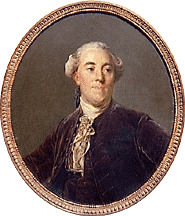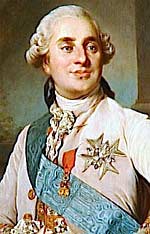| |
Overview
The storming of the Bastille on July 14, 1789 was an important development in, and later a symbol of, the French Revolution. Though at the time the Bastille contained only seven prisoners, its taking marked the beginning of open rebellion against the king. The anniversary of the event is still celebrated as Bastille Day, France's national holiday.
Historical Background
| Discover France recommends: |
| |
The Old Regime and the Revolution, Volume II
by Alexis de Tocqueville, François Furet & Françoise
Melonio (Editors), Alan S. Kahan (Translator).
Publisher: Univ. of Chicago Press (September 2001).
Hardcover, 528 pages.
Customer rating:  |
 |
 |
Synopsis
This new translation of Tocqueville's final masterpiece, written in
1851, focuses on the meaning and origin of the French Revolution. |
During the reign of king Louis XVI, France was forced to confront a major financial crisis which had been brewing for decades. On May 5, 1789, the Estates-General of 1789 convened to deal with this issue, but was held back by archaic protocols and the conservatism of the Second Estate. On June 17, 1789, the representatives of the Third Estate reconstituted themselves as the National Assembly, a body whose purpose was the creation of a French constitution. The king initially opposed this development, but was forced to acknowledge the authority of the assembly, which subsequently renamed itself the National Constituent Assembly on July 9.
Paris, close to insurrection, and, in François Mignet's words, "intoxicated with liberty and enthusiasm," unanimously expressed its support for the Assembly. The press published the Assembly's debates; political debate spread beyond the Assembly itself into the public squares and halls of the capital. The Palais Royal and its grounds became the site of a continuous meeting. The crowd, on the authority of the meeting at the Palais Royal, broke open the prisons of the Abbaye to release some grenadiers of the French guards, imprisoned for refusing to fire on the people. The Assembly recommended them to the clemency of the king; they returned to prison, and received pardon. Their regiment now leaned toward the popular cause.
Necker's Dismissal
| |
|

Jacques Necker, ca. 1781
portrait by
Joseph Siffred Duplessis
on exhibit at Versailles
(Musée National du Château
et des Trianons) |
|
| |
On July 11, 1789, with troops at Versailles, Sèvres, the Champ de Mars, and Saint-Denis, the king, acting under the influence of the conservative nobles of his privy council, banished his finance minister, Jacques Necker, who had been sympathetic to the Third Estate, and completely reconstructed the ministry. The marshal Victor-François, duc de Broglie, la Galissonnière, the duc de la Vauguyon, the Baron Louis de Breteuil, and the intendant Foulon, took over the posts of Puységur, Armand Marc, comte de Montmorin, La Luzerne, Saint-Priest, and Necker.
News of Necker's dismissal reached Paris in the afternoon of Sunday, July 12. The Parisians generally presumed that the dismissal marked the start of a coup by conservative elements. Crowds gathered throughout the city, including more than ten thousand at the Palais Royal. The young attorney Camille Desmoulins, according to Mignet, successfully rallied the crowd by "mount[ing] a table, pistol in hand, exclaiming: 'Citizens, there is no time to lose; the dismissal of Necker is the knell of a Saint Bartholomew for patriots! This very night all the Swiss and German battalions will leave the Champ de Mars to massacre us all; one resource is left; to take arms!'" (These foreign, mercenary troops were seen as especially loyal to the king, because they did not have the same ties to the general populace as ordinary French soldiers.)
Armed Conflict
| |
|
| |

Louis XVI, Roi de France
et de Navarre
(1754-1793)
portrait by
Joseph Siffred Duplessis
on exhibit at Versailles
(Musée National
du Château
et des Trianons) |
| |
A growing crowd, brandishing busts of Necker and of the duke of Orléans, passed through the streets to the Place Vendôme, where they put a detachment of the Royal-allemand (the king's German soldiers) to flight by a shower of stones. At the Place Louis XV, the dragoons of the prince de Lambesc shot the bearer of one of the busts; a soldier was also killed. Lambesc and his soldiers ran rampant, attacking not only the demonstrators but anyone in their path.
The regiment of the French guard favourably disposed towards the popular cause had remained confined to its barracks. With Paris becoming a general riot, de Lambesc, not trusting the regiment to obey this order, posted sixty dragoons to station themselves before its dépôt in the Chaussée-d'Antin. Once again, a measure intended to restrain only served to provoke. The French regiment routed their guard, killing two, wounding three, and putting the rest to flight. The rebellious citizenry had acquired a trained military contingent; as word of this spread, even the foreign troops refused to fight in what looked to be a civil war with a divided military.
The rebels gathered in and around the Hôtel de Ville and sounded the tocsin. Distrust between the leading citizens gathered within the building and the masses outside was exacerbated by the failure or inability of the former to provide the latter with arms. Between political insurrection and opportunistic looting, Paris reeled in chaos. In Versailles, the Assembly stood firm, and went into continuous session so that it could not, once again, be stealthily deprived of its meeting space.
GO TO NEXT PAGE »
The Bastille Is Stormed
|
|
